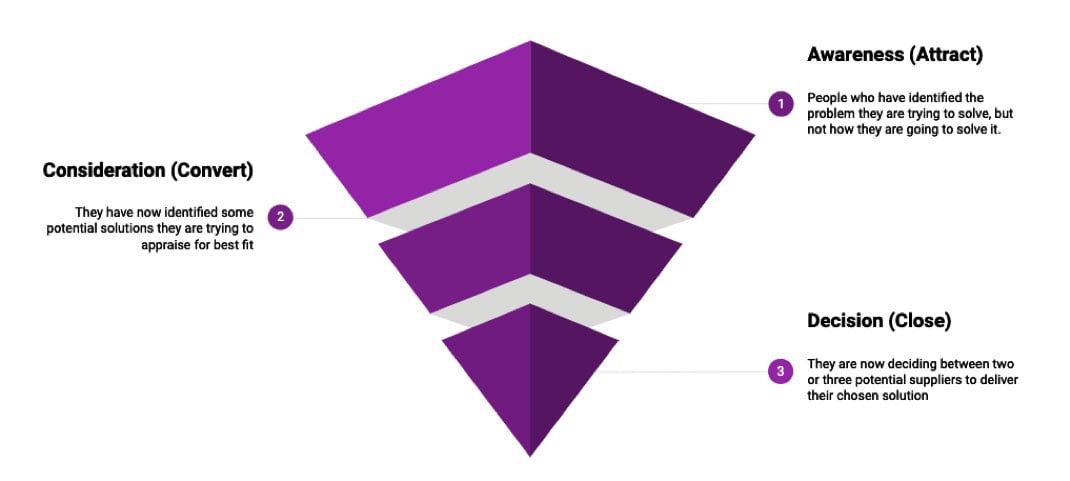Why you need to read this blog
You’ve decided to invest some time in creating content for your business, perhaps you’ve even hired a new member of staff to help you write blogs, film video content and create infographics. But if you want your content to be helpful and engaging, aiding problem solving and presenting a solution, you need to know what’s going through the heads of people when they are at the different of the buyer journey.
What are the stages of the buyer journey?
In simple terms these are:
What we tend to find is that business are good at getting prospects to visit their website and are then very good at asking them to commit to a conversation or to a purchase. However, much like going on a first date with an engagement ring, this is coming on a bit strong. The longest stage in the buyer journey is the bit in the middle – consideration. In fact, on average, for a high consideration purchase (one that takes some thinking about) the average time between first touch of a website and conversion is 123 days – 4 months.
With this in mind what you do in the middle to keep them engaged is the most critical part of the journey. Now clearly, they aren’t sticking around on your site for 4 months straight so the key to managing this part of the journey is ensuring you offer them something they are willing to swap their data for when they first arrive. This process is made even more complex by the multiple ways a customer can interact with your brand – website, social media, messaging, email and so on. Ask yourself, how many steps in your customer journey result in a data capture that doesn’t result in a member of your sales team immediately calling them to try to close a deal? If the answer is not many – read on.
What is the solution?
So, how can you get into your customers’ heads and find out exactly what they want and need at every stage of their journey? Unless you’re Amazon and have petabytes of behavioural preference data to help you, we would suggest you spend some time mapping the customer journey. A customer journey map is actually a visual representation of the process a prospect goes through to achieve a goal with your company, not just in terms of touchpoints, but the cognitive journey they go on. As they progress from awareness to making a decision your map will show you how what they are thinking and doing changes markedly. With the help of a customer journey map, you will be able to better understand your customers' motivations - their needs, challenges and pain points - to ensure your journey is providing them with the information they need, at the exact moment they need it most.
But I know my customers perfectly well already!
You probably do – after all, you know the questions you get asked most often as people move down the sales funnel, and you know the range of problems your product can help to solve. We would say this to you - by breaking down the customer journey into different phases you will see things slightly differently. You know so much about your company, so perhaps you struggle to see what it looks like to someone who doesn’t know what you do at all. Are you creating content for those people, the ones who have only just found you?
What else can this do for my business?
Mapping the customer journey delivers other, exiting benefits you’ll want to get your paws on, such as:
- It will allow you to define and narrow your target audiences. Marketing to everyone is incredibly inefficient and delivers poor results. Focused inbound marketing driven by a customer journey map will help you narrow down who you are talking to and why.
- It will help create a customer-centric mentality throughout your business. If you truly capture every stage, then you’ll encompass touchpoints from sales and service departments as well as marketing and therefore provide them with content to help them interact with customers.
How do I map the customer journey?
First up define the personas for your business. Who are the people you want to sell to, and where do they get their information from? What are their goals, challenges and pain points? These are your personas, and they form a big part of an effective inbound strategy.
You will then need to review all the touchpoints, those places where these people interact with your business. That will include your website, social media channels, email marketing, telephone on hold messages, brochures, landing pages, popovers... and so on!
Spend some time with different departments talking to the staff about their customer interactions, capturing the questions they get asked and the problems they help solve. It’s worth investing enough time and resource to do this as thoroughly as possible as the results of this exercise will be the bedrock of your content going forward. And the end aim of superb content and a solid inbound strategy? ROI!
Still a little lost? Drop us a line to see how we can help you!
